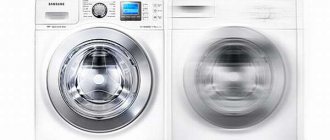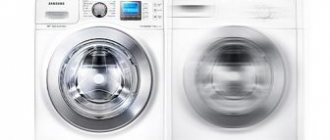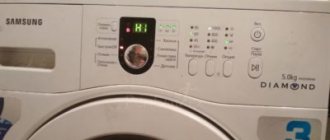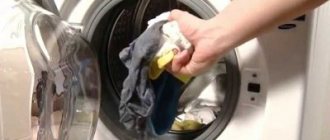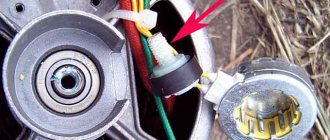Even in good condition, an automatic washing machine makes some noise and whistling, especially during intensive use, and this is completely normal. But there are times when the washing machine hums and rattles so much that it becomes annoying. In this situation, there may be a serious malfunction. In any case, this is a reason to think seriously and start looking for the cause of the unpleasant sound. We will talk about the causes of these sounds made by a washing machine, as well as ways to eliminate them, in this article.
Small object or foreign part
The washing machine hums and whistles during the spin cycle due to the fact that some small item has gotten into the space under the drum. Let's look at the main reasons why they get there:
- Clothes pockets are considered one of the main problems. Saving just a few minutes before washing, which you need to spend on double-checking, develops into a real disaster.
- Loading items with buttons, beads, accessories and bras comes with additional risks. Small items of clothing may come off during the main or spin cycle. Try to use laundry bags whenever possible.
- A child can quietly place a toy in the tank or something small in the powder tank.
Important : Always check your clothing pockets before washing.
In the long run, foreign parts can ruin the operation of the machine. To prevent this from happening, you need to extract the excess by following simple steps:
- Disconnect equipment from electricity.
- Remove the top and then the bottom walls.
- Find the heating element, disconnect it and unscrew it.
- Carefully remove all objects and debris from the hole.
- Assemble the car, performing the steps in reverse order.
Most models are equipped with a special sump with a debris filter. As a rule, it is located at the bottom of the front panel. In this case, it is enough to open the door and remove the dirty filter for cleaning. If the washing machine does not start spinning clothes silently, return to parsing.
Why does the washing machine hum and whistle when washing?
The washing machine is not silent during operation, but makes sounds - during washing, during rinsing or during the spin program.
But sometimes the car starts to rattle, hum, whistle and make noise very loudly, which does not have a positive effect on the human nervous system.
How to determine which noise is normal and which is not?
It all depends on the drive.
Bearings
One of the most common reasons why a washing machine is noisy during the spin cycle is problems with the bearings. The only element that protects them from water and air is a rubber seal. It is not surprising that over time, leaks occur on the part, and as a result of corrosion, the washing machine begins to whistle and make unpleasant sounds. Usually the oil seal lasts for 5-7 years of stable operation, after which it needs to be replaced.
To detect bearing failure, you need to manually rotate the tank. If you hear a crackling sound or feel play, it is necessary to urgently lubricate or replace the problem unit.
Important : bearing repair is a very labor-intensive process and requires compliance with all manufacturer’s recommendations. If you are not confident in your abilities, it is better to contact a specialist.
Step-by-step instructions for self-replacement:
- You need to start by removing the top and back covers, after draining the water and relieving the voltage from the device.
- Remove the powder dispenser and then carefully remove the control panel. Most often it is secured with simple latches or a few screws.
- Similar to clearing debris, remove the heating element, and then the pipes and counterweight.
- Dismantle the weights that are located below and above the tank to facilitate removal of the drum.
- Remove the belt from the drum and engine pulleys, and then unhook the part from the shock-absorbing springs.
- Carefully remove the assembly and unscrew the pulley to get to the bearing. This can be done using a hammer and a blunt chisel. It is worth noting that in some models you will have to disassemble the drum.
Important : use only lubricants recommended by the manufacturer.
The replacement process is quite simple. It is necessary to remove old parts from the sockets, and then clean the metal rings from dirt. The next step is to install the new parts in place and apply lubricant. A thin layer is sufficient for the seal, but the bearings must be thoroughly treated.
Assemble both the bearings and the seal correctly. The latter, if installed incorrectly, will begin to let air and moisture through again.
Main causes and solutions
In order to remove debris, you will need to remove the heating element and manually remove everything that has accumulated between the drum and the wall.
Often, after transporting a purchase, new owners forget to remove the shipping bolts from the tank. The bolts are required to ensure that the shock-absorbing springs in the drum are not damaged during transportation. If they are not released, a loud knock will be heard during operation of the device and extraneous vibration will appear. In order to solve the problem, you just need to unscrew these fasteners.
If the bearings are faulty, the washing machine is constantly noisy. Many models have several of these bearings. In order to check this unit, you need to disconnect the device from the power supply and try to turn the drum by hand. If it makes sounds and spins with force, then it’s time to change the bearings.
What kind of lighting do you prefer?
Built-in Chandelier
The weakening of the drum drive pulley is checked as follows: the device is started in test mode. In this mode, the part rotates slowly in one direction, then in the other. You will need to listen to see if a characteristic clicking sound is heard at this moment. If it is, then the drive is weakened. To correct this problem, remove the back wall of the machine and tighten the pulley nut.
Bolts for transporting the tank
To deliver equipment from production to your apartment in good condition, special fasteners and packaging are used. But with a washing machine everything is more complicated, since it consists of many moving parts. Manufacturers install shipping bolts that secure shock absorber springs.
Since the bolts secure the tank in a stationary state, it is strictly forbidden to turn on the machine with them. If the washer is working, it is recommended to cancel the program. It is necessary to unscrew all the bolts located on the rear wall of the machine. The number of clamps is indicated in the instructions; as a rule, there are 4, 3 or 2 of them.
How to remove bolts correctly:
- Unscrew the screws using a simple wrench or adjustable wrench. Loosen them, carefully remove them and store them.
- Close the resulting holes with special plugs or plugs. Otherwise, dust and moisture will enter the washing machine.
Tip : Don't throw away the shipping bolts as they may be needed in the future.
Video on the topic
The story is about the reasons why extraneous noise occurs in the washing machine and the procedure for eliminating them:
Electronic engineer with many years of experience. For several years I was engaged in organizing the repair of household appliances. I am glad to share with readers my knowledge in the field of operation and repair of devices. Loves sport fishing, water tourism and travel.
Found a mistake? Select the text with the mouse and click:
The dishwasher cleans more than just plates and cups. You can load it with plastic toys, glass lamp shades and even dirty vegetables, such as potatoes, but only without using detergents.
Before removing various stains from clothing, you need to find out how safe the selected solvent is for the fabric itself. It is applied in a small amount to an inconspicuous area of the item from the inside out for 5-10 minutes. If the material retains its structure and color, you can move on to stains.
Threads made of gold and silver, which were used to embroider clothes in the old days, are called gimp. To obtain them, the metal wire was pulled for a long time with pliers to the required fineness. This is where the expression “to drag out the rigmarole” came from - “to do long, monotonous work” or “to delay the completion of a task.”
There are special traps to combat moths. The sticky layer with which they are covered contains female pheromones that attract males. By sticking to the trap, they are eliminated from the reproduction process, which leads to a decrease in the moth population.
If your favorite things show the first signs of gestation in the form of untidy pellets, you can get rid of them using a special machine - a shaver. It quickly and effectively shaves off clumps of fabric fibers and returns things to their proper appearance.
The habit of using an automatic washing machine “sparingly” can lead to the appearance of an unpleasant odor in it. Washing at temperatures below 60℃ and short rinses allow fungi and bacteria from dirty clothes to remain on internal surfaces and actively multiply.
Fresh lemon is not only suitable for tea: clean dirt from the surface of an acrylic bath by rubbing with half a cut citrus, or quickly wash the microwave by placing a container of water and lemon slices in it for 8-10 minutes at maximum power. The softened dirt can simply be wiped off with a sponge.
Stretch ceilings made of PVC film can withstand from 70 to 120 liters of water per 1 m2 of their area (depending on the size of the ceiling, the degree of its tension and the quality of the film). So you don’t have to worry about leaks from neighbors above.
Failure of the centrifuge rotation axis
The centrifuge is responsible for the movement of the machine drum during washing and spinning. There are many causes of breakdowns, so it is difficult for an ordinary user to fix the problem on their own. Below are the main reasons:
- The tank is overloaded with laundry or water. The rated power of the element is limited, so any load above the norm may cause breakdown. Also, unevenly distributed laundry causes the tank to sway.
- Ingress of foreign bodies that block the rotation of the drum.
- A breakdown of the tachometer is characterized by a sharp change in the number of rotations, too high or low speed, and the items are wet or poorly wrung out after washing.
- The water sensor is faulty - it does not work or gives false readings. Signs include insufficient or excessive amount of water, turning on the heating without water.
The problem can be determined experimentally by first reducing the weight of the laundry per wash. If this does not help, you need to clean the insides of the machine from foreign parts, and then analyze the operation of the sensors and replace the faulty elements.
Precautionary measures
In order for the machine to work for a long time, you must adhere to certain rules.
- You need to be vigilant and carefully inspect things for small parts that may come off during washing and get into the tank. It is better to put such things in a special laundry bag.
- Remove money and other small items from your pockets that could damage the machine during the washing process.
- Protect the heating element from scale that forms from hard running water. To do this, you need to use water softening and descaling products.
- It is necessary to move the washing machine at least once every six months and check the serviceability of the hoses, as well as flexible wiring and pipes for damage.
- Wash and clean the drawer for powder and rinse aid. If this is not done, hardened powder particles may accumulate in the machine, which will interfere with the normal operation of the equipment.
- After each wash, leave the powder container and the machine door open. This is necessary so that the internal parts of the washer dry thoroughly.
We invite you to familiarize yourself with the operating principle of the drying machine: types, design, drying modes
All these recommendations will help extend the life of the washing machine and protect it from frequent breakdowns and calls to service centers.
Some types of repairs can be carried out independently, but still, if the breakdown is serious, it is best to contact a service center and call a specialist to your home.
Counterweight is poorly secured
Also, when spinning, the washing machine makes a lot of noise and rattles due to problems with the counterweight. The part is necessary to make the tank heavier, reduce vibration and provide stability. Counterweights are made of cast iron, plastic or concrete, and the latter break and crumble more quickly.
The most common problem with counterweights is poor fit. Over time, the washing machine, operating at high speeds, weakens the fastening. At the same time, the counterweight begins to vibrate and rattle during the spin cycle.
To solve the problem, simply remove the back panel of the machine and check the tightness of the mounting bolts. As a rule, this helps. If it is visually discovered that the counterweight is damaged, it needs to be replaced.
Clogged drain filter
In most cases, the cause of noise when pumping water is a faulty inlet valve. If your washing machine is slow to fill with water or cannot fill at all, this is a clear sign of a broken inlet valve.
If water is drawn in, but more slowly than usual, there is a possibility that the mesh on the inlet pipe is simply clogged. You need to turn off the water supply and unscrew the water supply hose from the machine. There is a plastic mesh installed in the body of the machine. It must be cleaned or replaced if damaged.
If you do not feel confident enough to do this yourself, we recommend that you consult with a specialist from our service center.
Expert opinion
It-Technology, Electrical power and electronics specialist
Ask questions to the “Specialist for modernization of energy generation systems”
Washing machine whistling during the spin cycle: causes and solutions If you do not figure out in a timely manner why the washing machine makes a lot of noise during a quick spin cycle, the device may stop completely. Ask, I'm in touch!
If the vacuum cleaner does not suck up dust
The reasons for poor absorption of debris and dust may be the same as for overheating. To identify the problem, you should perform the following steps step by step:
- First, be sure to disconnect the device from the network;
- Next, a general inspection of the device is carried out;
- It is worth making sure that the selected mode is correct - perhaps the parameters are simply wrong;
- If all this does not help, then you should disassemble the unit: disconnect the pipe and brushes, then remove the body and inspect the insides (dust bag or container, filters, engine).
If a malfunction is detected, you should begin to eliminate it.
The bag is overflowing
A common reason for weak vacuum cleaner traction can be an overfilled dust and debris bag: some older models do not have a fullness indicator, so you should regularly check the bag's fullness level yourself. When the dust container is 70% full, the suction power may decrease significantly or disappear altogether.
During the emptying process, it is necessary to examine the material from which the bag is made:
- paper bags are disposable, so they can only be replaced with a new one;
- fabric bags can be washed in plain water and put back in place after drying.
If everything is in order with the dust collector, but the draft still does not appear, then you can proceed to the next stage.
The filter is clogged
If the vacuum cleaner does not suck, it may be due to the filters. Any model contains 2 filters, one of which is used for fine cleaning, and the second is exhaust. If the exhaust filter has never been replaced, it should be done now - it must be changed every 50 hours of operation. The fine filter should be cleaned or changed regularly: you can wash it with warm water and then dry it thoroughly. Filters are usually located near the back of the device.
Dirt in the hose or brush
A drop in suction power sometimes occurs due to a damaged hose or nozzle. First, you should carefully inspect the suction pipe and inspect the place where it is connected to the body - the pipe may not be fully seated or not fit tightly. If there are blockages in the pipe, it is necessary to clear them with wire. Next, you need to check the hose for damage: to do this, you can disconnect it from the device and put your hand on the inlet. If the traction is good, then the reason lies in the hose.
You should also examine the nozzle - sometimes it causes poor performance of the device. It is necessary to clean the brushes from threads, hair and other debris, and also check for permeability inside. The bearings should also be checked for proper operation, because the force of the air flow depends on them.
Damage to the device
To gain access to the main part of the vacuum cleaner, remove the housing protection. Usually this unit stops functioning due to a blown fuse - you can check it with a multimeter. If the fuse is faulty, select one with similar parameters and install it in place. If the contact is broken, this can also cause a malfunction - solder the damaged contact in place with a soldering iron. If you suspect that the motor brushes are malfunctioning, you should work extremely carefully - an incorrect connection can lead to the device starting to work in the opposite direction and simply blowing out dust. If the winding on the coil breaks, you should prepare to replace the unit or buy a new vacuum cleaner.
Each model has its own weaknesses. In LG models, graphite brushes begin to become unusable after prolonged use, and in Samsung devices, sometimes there are winding insulation failures, which ultimately leads to an interturn short circuit.
Important! A faulty engine is practically impossible to repair on your own and will require the help of competent specialists to restore it.
Calling a Samsung repairman: where to find it, how to avoid falling for scammers?
In a situation where self-diagnosis and repair of a Samsung washing machine did not lead to the desired result, there is only one thing left to do - call a professional technician.
It’s worth finding out in advance how to do this correctly so as not to encounter scammers.
TOP 5 most popular and effective ways to find a washing machine repairman:
The first leading place in the ranking is occupied by an online service for selecting repair specialists. There are a sufficient number of services, registration on which will help you quickly select a specialist and apply for repairs. The advantages of this method: accessibility anywhere in the country, round-the-clock access to the necessary information, a large selection of specialists at various levels. The disadvantages include not always truthful reviews, which can affect the final choice.
The second item in the ranking is newspaper advertisements. This is a fairly popular and familiar search for a master. A phone call allows you to immediately discuss the details of interest, the cost of the work, and also draw up a preliminary portrait of the person who may come to the call. One of the disadvantages of this method is the amount of time spent on calling. The third place of honor in the ranking is occupied by the so-called “word of mouth”. It would seem that what could be more reliable is the recommendations of a friend. But you should never forget that the previous client’s opinion is based not only on the results of the master’s work. A person can formulate a review based on personal feelings
So, for example, being in a not very good mood, few people pay attention to the positive qualities of the master, paying attention only to his shortcomings and shortcomings. The fourth place is occupied by service centers. The advantage of such organizations is that both the master and the client are always legally protected (a service agreement is drawn up)
It is this official document that will become the basis for legal proceedings in the event of unsuccessful repair of the washing machine. The last place in the ranking of the most popular ways to find a craftsman is advertisements on a pole. Of course, this method is not relevant for large cities, but for small towns and villages, advertisements on a bus stop pole will help you find a good local washing machine repair professional.
To avoid dealing with scammers, when choosing a specialist, you should pay attention to the following:
- the master, without studying the problem, immediately names the final diagnosis and the amount of future repairs;
- the so-called “specialist” demands advance payment (even partial) for work not yet completed.
The above signs indicate that most likely the master is a fraudster whose services you should refuse.
The final cost of washer repair depends on many factors:
- price of components,
- urgency of order fulfillment,
- complexity of work.
On average, replacing a lock will cost from 1,500 to 2,500 rubles, replacing a drain filter up to 2,500 rubles, replacing a drain pump up to 4,500 rubles, repairing a module up to half the cost of a new unit.
Find out more about repairing Samsung washing machines in this section.
